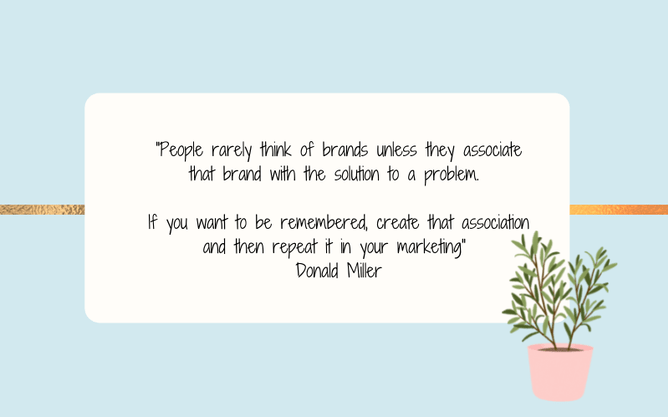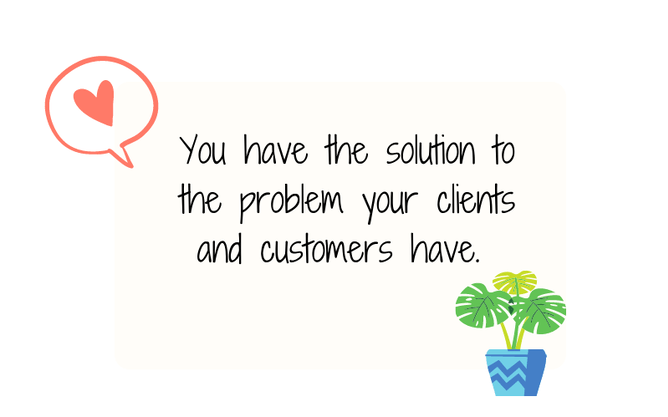(And why you need to tell your customers!)
People are searching for solutions to their problems but many businesses avoid talking about their client's problems.
Compassionately acknowledging your client's problems and offering them a solution is one way we can increase bookings and sell more products.
But, many small businesses shy away from using problem-based marketing - it can have a slightly icky, sleazy feel to it!
I’m here to show you how you can boost your marketing efforts (remember, work smarter not harder) by defining the problem your product or services solves and still be ethical, authentic and compassionate.
Why problems sell
When you sit down in front of Google and ask it a question I can pretty much guarantee that you’re seeking a solution to a problem. Am I right?
Think about it? What was the last thing you Googled?
Your problem might be “where’s the nearest bubble tea shop?”, “how to fix a dropped hem without a sewing machine?”, or “nutritionist near me”.
Whatever your problem, Google has the answer (let’s not go into how it knows the best answer to present to you!!! That’s a whole different minefield.)
So, it makes sense that you present them with their problem and offer up your solution.
Why does talking about their problem feel so icky?
Sometimes we think that talking about the problem can feel like we’re just pressing in on those pain points and triggering our clients in an effort to make the sale.
Yes, there’s totally a right way and a wrong way to talk about your client’s problems.
Here are some of the wrong ways!
- Scaring them.
- Using fear.
- Amplifying bad outcomes.
- Making up bad outcomes.
- Dwelling on the negativity
All these things are BAD. Yup. Just downright nasty marketing. Don’t do it.
I’m not denying it can work to get the sale. But it just ain’t right.
You see, our brain is programmed for two things - survival and thriving.
Whatever we come up against, our primal instinct is to do what we can to survive. That’s what fear-based marketing taps into.
What problem does your product or service solve?
The best way to find out what problem your product or service solves for your clients is … ask them!
Go back through discovery call notes and see what people said when you asked “how can I help”.
Start asking your customer “what problem are you experiencing that I can help you solve?”
What gives you superpowers by looking at these answers is that you can use your client’s actual words when defining problems.
Not got any clients to ask? Head to Amazon, find a product that fits the category of service or product you offer and read the reviews! Or try TrustPilot to read reviews.
Look for
- Repeatable words, phrases or concepts
- What problems are prioritised over others?
When you’ve found the problem you solve for your clients (in their own words), try drilling down a bit deeper.
Identify the problem. And ask yourself “so what?” Why is this problem? What does this problem look like in their life? How does this problem make them feel?
This helps you find out why this is a problem or the consequences of it being a problem.
Talking about your client’s problems with compassion
Although we need to acknowledge the problem to help show our clients that we get it, dwelling on the problem is like over-salting the bread - it kills the rise.
Focus on the positive
Bring people into the conversation you’re having with them (whether it’s in an email, on a sales page, in a social media post or during a discovery call) by focusing on the dream they want to achieve - their goals.
Show them what is (realistically) possible. Flip the problem into the solution and use this to grab their attention and trigger their curiosity.
Bring in the problem
Once you’ve shown them their dream can become a reality briefly tell them you get it. You understand the problem. Whether it’s because you’ve been there and done it, or you’ve helped many people with that problem. And you know how life was like for them when they were experiencing the problem.
Show them the solution
Now it’s time to show them the solution.
Many of my clients are fantastic at showing their clients the facts about what they do that solves the problem. What they miss are the emotional solutions they bring. Tell people how they feel when they don’t have the problem anymore. How does that link in with the tangible features of the service or product you’re presenting as the solution?
What next?
Now you know the problem your product or service solves for your clients, you can incorporate it in all your marketing.
But remember, just a pinch of problems!
The StoryBrand 7-step framework and customer research I do for my clients as part of my Marketing Playbook and website copy allows us to pinpoint your clients’ problems and incorporate them compassionately into marketing the solutions you provide.
Isn’t it time we talked about taking your marketing up a notch?




